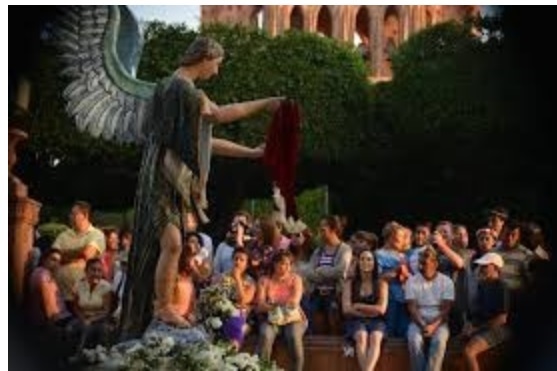Last year I was in the state of Chiapas enjoying the indigenous traditions there when on a tour of a church the guide twice pointed to a man at Jesus’ Crucifixion beside Mary, Jesus’ Mom, stating he was Jesus’ father, St. Joseph.
I winced knowing St. Joseph wasn’t there, he was Jesus’ step-father and that the lad was actually Jesus’ apparent favorite apostle, St. John. Keeping my thoughts to myself (snitches get stitches) the situation made me realize how complicated it can be to keep straight the cast of characters here in San Miguel de Allende’s Semana Santa (Holy Week, or the week before Easter). These folks appear in countless processions, plays, and displays and here is rundown on who is who.
The star is obviously Jesus, typically seen alongside his cumbersome cross. Other times he is seen bent over a column (an image aptly named Senor of the Column) being whipped in his very own procession from Atotonilco two weeks before Easter. This image receives special attention for his historical role in having ended a Colonial era plague.
But he’s not the only plague person. Often in Holy Week processions there is man whose hair and costume, not to mention pet, indicate another era. He stands lifting his skirt to show a scar on his leg while beside him is a dog carrying bread. That is St. Roque (Roche, Rocco, Rock). He is showing us he has the plague and, for that, he was kicked out of Rome. He survives living in the wild via a dog that brings bread daily and licks his wound until the plague goes away. This makes St. Roque patron of both plagues and dogs.
Plagues were mysterious and frequent for centuries and invoking the help of Senor of Column or St. Roque helped give an approach to combat the randomness of plagues. Rather than a society depressed and resigned to repeated ravages of plagues, these lads gave folks positive steps to regain control over their environment. The display Senor of Column and St. Roque this time of year is in appreciation for their early efforts.
There are apostles around town this week. One is Judas Iscariot, the apostle that turns Jesus in for 30 pieces of silver. He normally is shown hanging from a tree with said silver as he committed suicide Holy Week.
The other apostle is the teacher’s pet, St. John. St. John, in art, is the apostle without a beard and with a certain effeminate look including long hair. Often he is mistaken for St. Mary Magdalene and is physically closest to Jesus. One of Jesus’ last actions was to give his mother, Mary, to the care of St. John as her new son.
At the procession for Jesus’ burial will be Nicodemus and Joseph of Arimathea, whom carry a document where Pontius Pilate authorizes them to take Christ down from the cross and bury him with an abundance of the customary embalming spices. They are surrounded by Roman soldiers to insure Jesus’ body does not get stolen, as Pontius Pilate ordered.
 Then there are Jesus’ neighbors on the cross, Gestas and St. Dimas. Gestas, the bad thief, is shown as ugly and evil and was once modeled in art after a local butcher. I can only hope his meat showed better. The kinder lad is St. Dimas, the good thief, and only person we know for sure is in Heaven as Jesus tells him he’ll catch up with him later that day there. Often the cross bar of St. Dimas points up to show his ascent to Heaven while Gestas’ cross points down.
Then there are Jesus’ neighbors on the cross, Gestas and St. Dimas. Gestas, the bad thief, is shown as ugly and evil and was once modeled in art after a local butcher. I can only hope his meat showed better. The kinder lad is St. Dimas, the good thief, and only person we know for sure is in Heaven as Jesus tells him he’ll catch up with him later that day there. Often the cross bar of St. Dimas points up to show his ascent to Heaven while Gestas’ cross points down.
Other men in the procession are gladiators, as Jesus was a prisoner.
For the gals, Mary, his mother is the lead female part and is identified by her trademark blue and purple clothing (the colors of mourning). Notably absent is her husband, St. Joseph, her parents (St. Ana and St. Joachim) and her cousin, St. Elizabeth (mother of the also missing St. John the Baptist). For this reason they are all believed to have pre-deceased Jesus.
Present is Mary’s half-sister, Mary of Clopas. Mary’s mother, St. Ana, is believed to have been married thrice giving birth to a baby girl named Mary each time. Apparently St. Ana wasn’t horribly creative on the baby-naming front but there are other Marys too.
St. Mary Magdalene was Jesus’ gal pal and many believe she was his amour. For centuries the Church promoted her as a prostitute though today it is acknowledged she was simply a wealthy woman from the area called Magdala who followed Jesus and his teachings. It is normally her right alongside the Virgin Mary and St. John.
There is also St. Martha, St. Lazarus’ and St. Mary’s sister. Confused? Hard not to be. The three siblings were Jesus’ pals for many years and whom he spent the most of his time with beyond the Apostles and St. Mary Magdalene.
Then there are the nameless and genderless angels. Normally they look like highly effeminate men and are present to aid the Virgin Mary in her agony of losing Jesus.
 Now for those of you who know your bible these featured folks are often nameless much less with back stories. All this storytelling was an attempt to make the characters more relatable to the indigenous. As a conquered people they didn’t feel able to talk to Jesus directly (that is a Protestant concept that came later) but the Virgin Mary, and these Saints, were all humans just like them, and us. Thus the Virgin Mary was more accessible to ask favors of. Plus a lad has to do what his Mom asks of him. (You can’t be the Son of God, without a mother.)
Now for those of you who know your bible these featured folks are often nameless much less with back stories. All this storytelling was an attempt to make the characters more relatable to the indigenous. As a conquered people they didn’t feel able to talk to Jesus directly (that is a Protestant concept that came later) but the Virgin Mary, and these Saints, were all humans just like them, and us. Thus the Virgin Mary was more accessible to ask favors of. Plus a lad has to do what his Mom asks of him. (You can’t be the Son of God, without a mother.)
Being able to recognize all the characters of Semana Santa makes your time in SMA more meaningful and enjoyable! Hoppy Easter!
Joseph Toone is the Historical Society’s short-story award winning author of the SMA Secrets book series. All books in the series are Amazon bestsellers in Mexican Travel and Holidays. Toone is SMA’s expert and TripAdvisor’s top ranked historical tour guide telling the stories behind what we do in today’s SMA. Visit HistoryAndCultureWalkin




